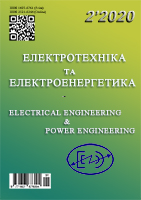Method of calculation of steady-state processes in electrical circuits
DOI:
https://doi.org/10.15588/1607-6761-2020-2-3Keywords:
, steady-state process, numerical methods, circuit model, polynomial approximation, Tchebyshev’s polynomialAbstract
Purpose. Development of a method for calculating established periodic processes of complex shape
Methodology. Polynomial approximation of functions, numerical methods for solving integro-differential equations, mathematical apparatus of matrix algebra, computer programming and methods of electric circuit theory are used.
Findings. As a result of modification of the known method for calculating transient processes, a method has been developed that allows you to directly perform the calculation of steady-state periodic processes. This will reduce the time of computer simulation of electrical processes in linear electrical circuits. An example of using the proposed method is shown. Based on the developed method, a computer program for calculating the steady-state process in the model circuit is worked out. This example shows a 45% reduction in CPU time compared to the use of known methods.
Originality. Processes in electrical circuits are described by integro-differential equations. The approximation of functions of current derivatives to time by series on orthogonal Tchebyshev’s polynomials is used in their solution.When approximating functions, Chebyshev polynomials have uniform error in the whole range of argument change. It is advantageous stand out them from a number of other orthogonal functions. The proposed method uses a polynomial approximation not of the solution function itself, but of its derivative. The function itself is obtained with the help of integration operation. This operation has a small margin of error compared to the differentiation operation. The direct calculation of the steady-state periodic process is achieved by taking the initial conditions for currents and their derivatives at the beginning of the period as the values of the same functions at the end of the period. In the proposed method, integro-differential equations of state are transformed into linear algebraic equations. A method for creating a unified system of linear algebraic equations is proposed. The solution of this system allows you to perform directly the calculation of steady-state periodic processes.
Practical value The developed method opens a new possibility of using a diverse apparatus of the electric circuits theory to work with images of currents. Based on this method, a universal software package is developed for calculating steady-state periodic processes in electrical circuits of arbitrary complexity. This will reduce the CPU time for modeling complex circuits.
References
[1] Demirchyan, K.S., Nejman, L.R., Korovkin, N.V., Chechurin, V.L. (2003). Teoreticheskie osnovy` e`lektrotekhniki. Vol. 2, Piter, 567.
[2] Ortega, Dzh. (1986). Vvedenie v chislenny`e metody` resheniya differenczial`ny`kh uravnenij. Moscow, Nauka, 288.
[3] Segeda, M.S. (2002). Matematichne modelyuvannya v elektroenergeticzi. L`vi`v: L`vi`vs`ka poli`tekhni`ka, 300.
[4] Zig`mund, A. (1965). Trigonometricheskie ryady`. Vol. 2. Moscow, Mir, 538.
[5] Aprille, T.J., Trisk, T.N. (1972). Steady state analysis of nonlinear circuits with periodic inputs. IEEE Trans. Circuit Theory, Vol. 60, No 1, 108-114.
[6] Malyar, V.S., Dobushovs`ka, I`.A. (2011) Rozrakhunok ustalenikh rezhimi`v u nelinijnikh elektrichnikh kolakh z reaktivnimi elementami i` nesinusoyidnimi dzherelami zhivlennya. Vi`snik Naczi`onal`nogo universitetu "L`vi`vs`ka poli`tekhni`ka", Elektroenergetichni` ta elektro-mekhani`chni` sistemi. No 707, 82-86.
[7] Malyar V.S., (2000). Rozrakhunok statichnikh kharakteristik peri`odichnikh proczesi`v diferenczi`al`nim splajn-metodom. Teoretichna elektrotekhni`ka, No 55, 37-42.
[8] Tikhovod, S.M., (2001). Metod rascheta ustanovivshikhsya i perekhodny`kh proczessov v slozhny`kh nelinejny`kh czepyakh. E`lektrotekhnika i e`lektroe`nergetika, No 2, 5-9.
[9] Tikhovod, S.M. (2007). Sovershenstvovanie metodiki rascheta ustanovivshikhsya proczessov v e`lektricheskikh czepyakh peremennogo toka. Elektrotekhni`ka ta elektroenergetika, Vol. 2, 29-33.
[10] Lomonosov, V.Yu., (1952). Periodicheskie proczessy` v ne-linejny`kh czepyakh. E`lektrichestvo. Vol. 7, 55-58.
[11] Patalakh, D.G., (2019). Modifikacziya metoda chislennogo rascheta perekhodny`kh proczessov v e`lektricheskikh czepyakh na osnove polinomov Cheby`sheva. Elektrotekhni`ka ta elektroenergetika, Vol. 4, 11-24.
[12] Vasil`ev, N.I., Klokov, Yu.A., Shkerstena, A.Ya., (1984). Primenenie polinomov Cheby`sheva v chislennom analize. Riga, Zinatne, 240.
[13] Danilov, Yu.A., (1984). Mnogochleny` Cheby`sheva. Minsk, Vy`she`jshaya shkola, 157.
[14] GNU Octave [E`lektronny`j resurs]. – rezhim do-stupa:http://www.gnu.org/software/octave/index.html .– zagolovok s e`krana . – Yazy`k angl.
[15] Anufriev, I.E., Smirnov, A.B., Smirnova, E.N., (2005). MATLAB 7. BKhV-Peterburg, 1104.
T`yuarsson, R. (1977). Razrezhenny`e matriczy`. Moscow, Mir, 172 s.
Downloads
Published
How to Cite
Issue
Section
License
Copyright (c) 2020 D. Patalakh, S. Tykhovod

This work is licensed under a Creative Commons Attribution 4.0 International License.
Creative Commons Licensing Notifications in the Copyright Notices
Authors who publish with this journal agree to the following terms:
Authors retain copyright and grant the journal right of first publication with the work simultaneously licensed under aCreative Commons Attribution License that allows others to share the work with an acknowledgement of the work's authorship and initial publication in this journal.
Authors are able to enter into separate, additional contractual arrangements for the non-exclusive distribution of the journal's published version of the work (e.g., post it to an institutional repository or publish it in a book), with an acknowledgement of its initial publication in this journal.
Authors are permitted and encouraged to post their work online (e.g., in institutional repositories or on their website) prior to and during the submission process, as it can lead to productive exchanges, as well as earlier and greater citation of published work.

